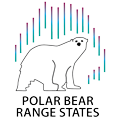- You are here:
-
Home

-
Resources

-
Meeting Documents

-
PBRS Meeting of the Parties (MoP)

-
2018 – Fairbanks, Alaska, USA

-
Presentations and Meeting Documents

- 7.1 Canada Research Report
7.1 Canada Research Report
Presentation Title: Polar Bear Research in Canada:
Understanding Ecology, Environmental Change and Sustainability
Summary: This presentation highlights Canada’s coordinated approach to research that is currently focused on four key research areas including habitat and climate change, population status, genetics/health, and foraging ecology/ecosystem dynamics). Climate mediated changes to the availability of sea ice have resulted in changes in growth, body condition and survival in several polar bear populations. Changes in sea ice dynamics have also resulted in changes in movement and habitat use that are continuing to be monitored. Assessing population status is a critical component of polar bear research in Canada that helps ensure sustainable harvest and track population level responses to change sea ice conditions. In addition to estimating population abundance, understanding the health of polar bears is an important component of overall population status. Polar bear health is also influenced by the availability of prey and recent research has indicated that cycling in ringed seal populations is likely to influence polar bear foraging success. Similarly, reductions in the availability of sea ice habitat have resulted in polar bear foraging in terrestrial environments. We discuss the results of these research findings in the context of polar bear conservation and management in Canada, and ultimately population status. Other polar bear research efforts are briefly summarized, including movements influencing genetic structure, evidence that body size is under selection and heritable, long term declines in body conditions, increased long distance swimming rates, prey abundance and availability influencing nutritional condition, population cycling in key prey species, and regional-scale variation in response to changing climate. Monitoring polar bear populations involves conducting physical mark-recapture, genetic mark-recapture, aerial surveys, satellite monitoring, photo surveys, and using drones. Genetics and health research involves using hair as a matrix to assess polar bear health, developing filter paper sampling for contaminant analysis, monitoring contaminants, conducting temporal studies of disease prevalence, and assessing body condition through the use of multiple metrics. Polar bear health depends on cycling and productivity in ringed seal populations, and foraging ecology and ecosystem dynamics research to date has demonstrated that polar bears are spending more time foraging in terrestrial habitats. Other polar bear research efforts are briefly summarized.
| File Name: | 7.1_Richardson_Canada_research_update.pdf |
| File Size: | 4.16 MB |
| File Type: | application/pdf |
| Hits: | 4287 Hits |
| Created Date: | 02-22-2018 |
| Last Updated Date: | 02-22-2018 |
Categories Tree
-
-
-
-
-
-
-
-
-
-
-
-
-
-
|- HBC-5 Output
-
|- HBC-7 Output
-
-
-
-
-
-
-
-
-
-
-
-
-
-
-
-
